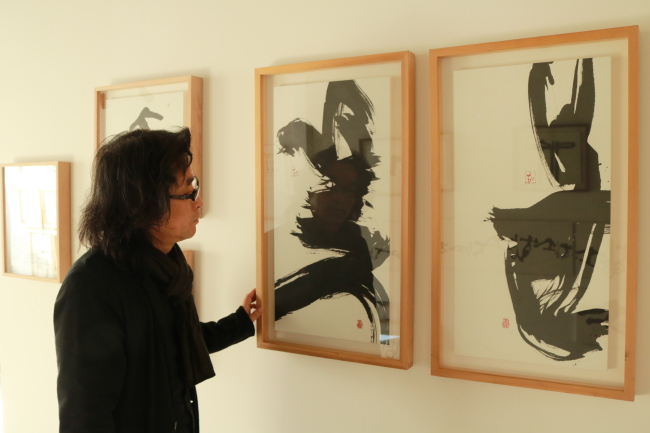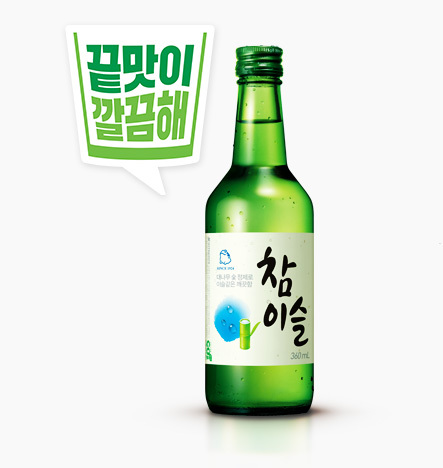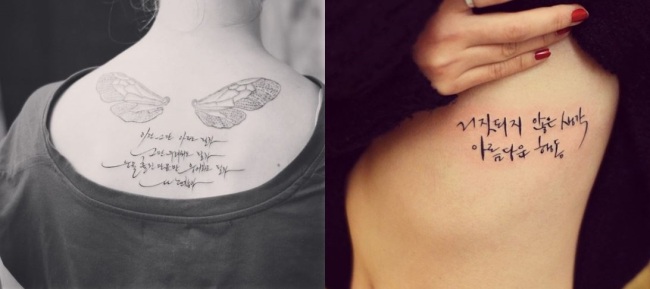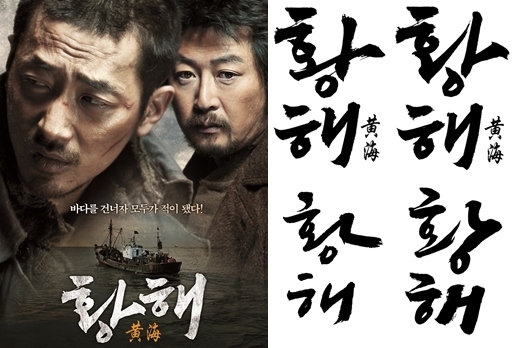There was a time when Chinese character calligraphers criticized Hangeul calligraphy for being “too unsophisticated.”
Luckily, a few calligraphers ignored the comments and mastered their craft in Hangeul, the Korean alphabet. Looking back, they served as the trailblazers for the now-burgeoning market for Hangeul calligraphy.
“Years ago, the term ‘Hangeul calligraphy’ was virtually nonexistent among graphic designers,” Kang Byung-in, one of the first-generation Hangul calligraphy gurus, told The Korea Herald. “Now, more and more people seem to recognize its beauty.”
 |
Calligrapher Kang Byung-in (Son Ji-hyoung / The Korea Herald) |
Since the mid-2000s, Hangeul calligraphy pieces began to feature in the logos of posters for popular TV programs and films, print advertisements, representations of corporate or brand identities, and even tattoos.
Clients from advertisers, as well as design studios, found spot-on Hangul calligraphy visually sensational and dynamic and began to keep close tabs on the trend.
“Some clients requested that we put calligraphy in their advertisements,” said Lee Ka-ram, manager at design studio Kkotsbom. “We also take calligraphy into account on our own while designing a poster. It depends on the mood that a draft proposal carries.”
“Clients felt inclined to put calligraphy on their advertisements, after they saw calligraphy design on our film posters,” said Lee Kwan-yong, art director of design studio Sputnik.
 |
The current brand identity of Korean soju brand Chamisul uses calligraphy (HiteJinro) |
The phenomenon has irrevocably sparked the demand of graphic designers adept at letter designs -- including calligraphy -- and encouraged young designers to expand their craft.
“Skills with visual images can be acquired with a series of trainings, but typography or calligraphy skill is an inborn talent.” Lee from Sputnik said. “We put skills to design letters to a priority when recruiting.”
Professionalism is also at work. Lee from Kkotsbom said, “Some graphic designers keen to letter designs hone calligraphy skills by themselves, for the sake of their own fulfillment.”
The surge in popularity for Hangeul calligraphy has not only been felt among conventional design studios. Many freelance designers and tattoo artists have also jumped on the bandwagon of this fairly new market trend.
“Hangeul tattoos have definitely become more popular in the last year or so,” said Lee Chun-soo, a tattoo artist in Hongdae, western Seoul. “I’ve been a tattoo artist for almost five years now, and before this year I never had to design a Hangeul tattoo for a client.”
 |
Hangeul tattoos by tattoo artist Lee Chun-soo (Instagram) |
Earlier this year, a young woman approached Lee for a Hangeul tattoo, but Lee was too unfamiliar with Hangeul calligraphy to accept her request. He called it an “embarrassing moment.”
“Then I realized that uniquely designed Hangeul tattoos could become a breakthrough market, especially if it was aimed at foreigners who wanted something distinctly Korean,” he said.
To some aspiring graphic designers, however, the popularity of calligraphy poses a burden, as it may be translated into yet another requirement or qualification for jobseekers.
“You can think of learning calligraphy as an equivalent to job-hunting students acquiring random certificates. It’s all about showing how dynamic and flexible your skills are,” said a design student at Seoul National University who preferred to be identified by his surname Ha. “An employer would rather hire somebody that has some basic form of mastery with calligraphy just in case they would need it in the future.”
Both Lee from Sputnik and Lee from Kkotsbom claimed calligraphy is not a prerequisite for a job application.
Acknowledgement as art?
Many designers and calligraphers agree that the 2002 Korea-Japan World Cup brought calligraphy into the mainstream of Korean graphic design. Before the sports event that drew massive crowds to the streets and plazas, clad in red shirts with “Be The Reds” on in unique writing, calligraphers struggled to get compensation when their work was used in advertisements.
It was not until 1996 that the South Korean court recognized the intellectual property rights of calligraphy as a creation. A design agency misappropriated some Hangeul calligraphy art by Wonkwang University professor Yeo Tae-myeong by disassembling the letters into clusters to create a letter design for the film poster for “Festival” (1996). After a court decision, the agency paid 20 million won ($17,000) for the copyright.
Calligrapher Park Yong-chul, who created the “Be the Reds” logo on red shirts for 2002 World Cup, was given the copyright for his work in December 2003, when a court decision was made in favor of the artist.
 |
Poster for “The Yellow Sea” (left, Showbox/Mediaplex) and title drafts for the poster for Korean movie “The Yellow Sea,” created by assembling clusters of Hangeul.(Sputnik) |
The issues regarding the cost and licensing of Hangeul calligraphy still linger. Professional calligraphers demand clients be charged with calligraphy pieces “separate from other graphic design features,” claiming clients and graphic designers have skirted the issue.
Top calligrapher Kang Byung-in argued the calligraphy market was “still in the making” and a shift in awareness was crucial to the survival of the entire calligraphy business.
“Every business entity should pay the right price for what should be licensed,” Kang said. “It is a matter of survival to full-time calligraphers.”
The graphic designers said that, in movie posters, calligraphy and other graphic design features are not separately priced, in part because in-house graphic designers can generate calligraphy for their works.
The Seoul-based studio Sputnik came up with an idea of assembling Hangeul clusters while working on posters for “The Yellow Sea” (2010). All graphic designers at the studio wrote the letters cluster by cluster and later assembled them, which led to “a myriad of Hangeul letters.”
“(Assembling clusters) could make fresh outcomes,” Lee from Sputnik said. “That’s how we differentiate ourselves from the calligraphers, whose scripts are increasingly standardized.”
By Son Ji-hyoung (
json@heraldcorp.com) and Lee Sang-won (
sangdoze@heraldcorp.com)











